ernest shazor
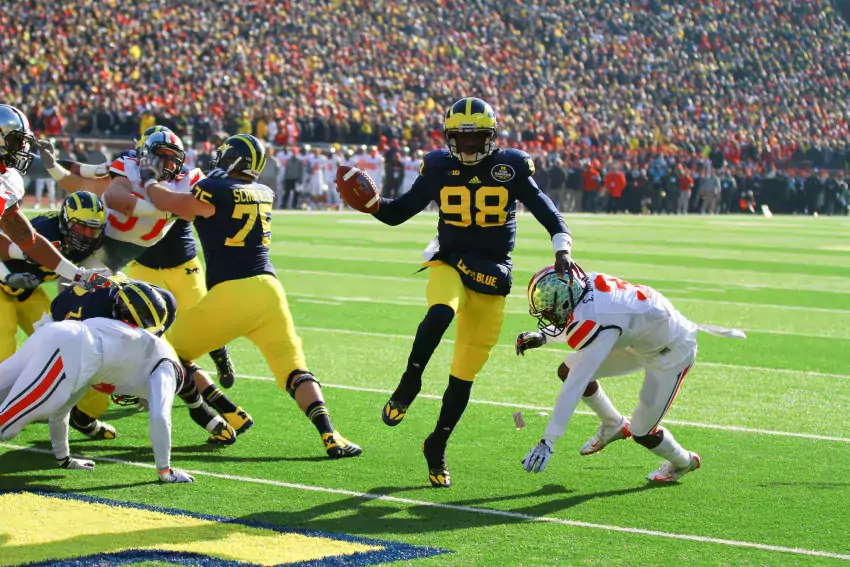
The gap.
Biggest gap for a Michigan athlete between their potential and their reality during their time at Michigan?
— Matthew Cheney (@matthewdcheney) March 17, 2021
This is a fascinating question. I'm going to leave out guys who saw their careers derailed by injury (Antonio Bass, Tarik Black) and also guys who the recruiting industry airballed on (Kevin Grady, Derrick Green) and limit this folks who clearly had something to offer and did not get to display it for whatever reason:
- Devin Gardner. Gardner looked like a Heisman contender at certain points (ND UTL II, the two point conversion game against OSU) and was battered to pulp by the worst pass protection of all time at all other points. Not too hard to see him in the NFL if he hadn't ascended to nirvana in the middle of an MSU game.
- Ernest Shazor. Electric hitter, five star recruit, repeatedly ran the wrong way at incredible rates of speed. He must have had some personal issues because he went from a projected second-round pick to completely undraftable in a couple months in which no football was being played.
- Donovan Peoples-Jones. Five star wide receiver with massive athletic talent who saw his QB exit the pocket repeatedly and avoid downfield shots even when they were blitheringly wide open. Might as well file Nico "60 targets" Collins in here too.
- Denard Robinson. Had just established himself as the most electric player in college football when Brady Hoke came in and brought in a guy who wanted to put him under center. Nerve injury had a lot to do with his late-career fade, too, but seeing Denard run a waggle will remain a crime against man and panda forever.
- Evan Smotrycz. Smotrycz was coming off a 53/44 shooting year and was a career 41% three point shooter on ~200 attempts when he decided to transfer to Maryland. A major reason for this was the fact that he got drafted into playing a bunch of center, which he openly loathed. He ended up being redundant with Jake Layman at Maryland and faded into being a bench player as a senior. There's an alternate Smotrycz history where he gets to be a stretch four under Beilein for four years and has an absurdly efficient statline as an upperclassman.
Protests?
Given the timing of #NotNCAAProperty do you think it's likely there will be an on court protest during the tournament?
— Mathew Puskar (@NoExtraT) March 18, 2021
That's impossible to project but I do feel like that day is coming closer every year. Getting garbage meals while quarantined in a hotel so that everyone except you gets paid buckets of cash does seem like a potential tipping point. At some point a team is going to realize that they have a considerable
I've advocated for teams to adopt a mini-boycott where they don't play for 15 minutes—and if the network cuts to commercial the counter starts over. That would be a wake-up call that could escalate if necessary.
[After THE JUMP: ravoli rebels]
left: Bryan Fuller
Earlier this offseason I stumbled onto an old article where Bill Walsh wrote what qualities he looks for when drafting various positions. Meant to be a one-off on the offense, I took requests for a defensive version and broke it up into D-Line, linebackers, and now, finally, the defensive backs. The idea is since the coaching staff is building a "pro-style" team with principles more akin to the Walsh ideal that dominates the pros than the collegiate evaluations made on scouting sites and the like, we shall re-scout the 2013 roster for Walsh-approved attributes.
Since coverages have changed the most since Walsh's day—a reaction to the spread—this is probably the least valuable of the series. To bring it back on point, I've gone off the page a little bit to note some of the attributes that NFL defensive coaches are looking for nowadays, and what those changes mean.
Strong Safety
Plankamalu / Shazorvacs/ M-Rob if all quarterbacks were Brian Cleary
Walsh Says: 6'3/215. Now hold your horses before going all "SHAZOR?!?" on me—I'm making a point: The type of player you have at safety depends on the type of system you want to run and the type of player you have everywhere else. If you're going to be playing more odd coverages (cover 1, cover 3) then you want your strong safety to be more of a run support guy, in many ways a fourth linebacker. If your base coverage is even (cover 2, cover 4) the strong and weak safeties will be more similar:
"There are other systems of defense where both safeties play a two-deep coverage and only occasionally come out of the middle to support the run. They basically play the ball in the air, the middle of the field and the sidelines. When you do that, then the stress is on the cornerback to be the support man.
So you must keep in mind these various philosophies when considering what types of cornerbacks and safeties you want to put together in forming a defensive secondary."
The attributes of your defensive backs should be complementary. Here's what Walsh is getting at: your backfield has to be able to defend the pass first and the run second. And here's the key: the more you can trust one player to handle coverage without help, 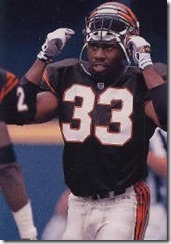 the more you can stock up on extra run defense with the other guys. If your backfield already has plenty of coverage, you can have a strong man:
the more you can stock up on extra run defense with the other guys. If your backfield already has plenty of coverage, you can have a strong man:
"The strong safety is historically the support man. He must have some of the traits you look for in a linebacker. In fact there have been some hybrid players in that position. Cincinnati had David Fulcher [right], who was as big as some linebackers but could function also as a safety. The Bengals moved him weak and strong, inside and outside and he became that extra man that the offensive run game had to account for but often could not block.
…
"But the typical strong safety is someone who can hit and stop people and respond spontaneously and go to the ball. Naturally, the more coverage talent the man has the more you can line him up on anybody."
Today, defensive coordinators sit on porches, remember when you could play a guy like Fulcher, and say "those were the days." The epitome of this type of safety is former Buckeye Doug Plank, who defined his position to such a degree that the defensive system itself was named for his number (46).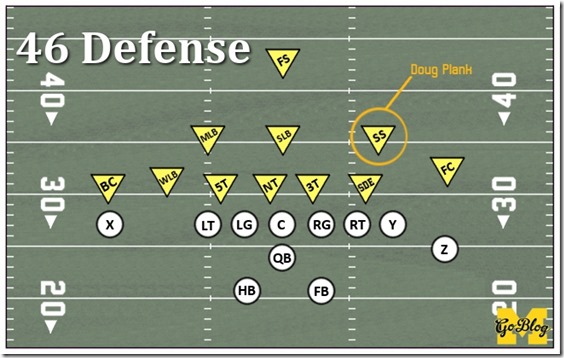
It's also called the "Bear" defense because it was the Bears
This defense was at the height of its popularity when Walsh joined the 49ers in 1979, and it was this defense his model passing concepts shredded. The defense played to Plank's strengths as an overly aggressive, hard-hitting run stopper with some coverage skills. The SAM linebacker in today's anti-spread sets (e.g. the 3-3-5's "Spur") is a closer analogue to the Plank-style player than the modern strong safety, with the key difference being that, as a safety, you couldn't put a blocker on a 46 without removing one from a lineman or linebacker, meaning the SS could flow cleanly to the point of attack and wrack up ridiculous tackle numbers.
College teams loved this, since passing quarterbacks were hard to come by and the big boys were running three yards and a cloud of dust (and later the option). A lot of cool names for linebacker-safeties were passed down from this period, such as the "Wolf" on Bo's teams, or the "Star" (names which today are coming out of retirement for the nickel-SAM hybrid position in base 4-2-5 anti-spread defenses).
Walsh's Favorite Wolverine: Why does a mid-'70s response to off-tackle NFL running games matter to a collegiate defense in 2013? Well because we have a really good free safety, and play tight end-heavy outfits this year in UConn (T.J. Weist, a rare member of the Gary Moeller coaching tree, is taking over there), Penn State, Michigan State, and Iowa, with the outside possibility of a Wisconsin if we make it to the conference championship. Also because the coaches have been subtly putting safety-like objects (Woolfolk, Gordon, and now Dymonte Thomas) at nickel, and recruiting a few linebacker-sized safeties.
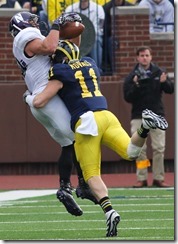 I don't know what he'd think of Kovacs. We loved him, but Jordan had two weaknesses: 1) his lack of overall athleticism made exploitable if left in wide coverage (see: his abusing by Ace Sanders on the last play of the Outback Bowl, and the utter disaster that was GERG's attempt to play Kovacs as the free safety in 2009), and 2) his lack of size made him blockable if a lead blocker could get to him (see: bad things happening whenever Mouton abandoned contain).
I don't know what he'd think of Kovacs. We loved him, but Jordan had two weaknesses: 1) his lack of overall athleticism made exploitable if left in wide coverage (see: his abusing by Ace Sanders on the last play of the Outback Bowl, and the utter disaster that was GERG's attempt to play Kovacs as the free safety in 2009), and 2) his lack of size made him blockable if a lead blocker could get to him (see: bad things happening whenever Mouton abandoned contain).
He would have loved Ernest Shazor, a knife blade listed at 6'4/226 with a scatback's acceleration who loved nothing better than demonstrating the force equation. Brian calls Shazor "the most overrated Michigan player of the decade" because he has to live with the bolded subconscious of UFR, and nothing pisses off a figment of a blogger's imagination like a safety who gives up a big play in coverage.
Here's the point: the ideal safety would be a dude with the size and stopping power to pop a lead blocker and make the tackle or lay out a guy like Shazor, read and react like Kovacs, and cover like Charles Woodson. That human doesn't exist. A combo of epic athleticism with plus headiness and serviceable tackling and size equals Ed Reed or Sean Taylor. Epic headiness with plus size and serviceable everything else nets you Doug Plank, with plus athleticism: Ronnie Lott, Troy Polamalu or Rodney Harrison. The trick is to have epic everything between your safeties; for strongside then it's not Ernest Shazor or Jordan Kovacs; it's SHAZORVACS!
What to look for in a Scouting Report: At either safety position, instincts rate highly and speed after that (less so for the strongside). You're looking to first make sure you have enough coverage in the entire backfield, and once you do you can use this position to stock up on linebacker traits: tackling, size, taking on blockers, personal contribution to local seismic activity, that sort of stuff.
What you can learn on film: Everyone loves those bone-jarring hits and coaches are more than happy to put them in a recruiting video, but not all hits are created equal. Sometimes they're generated by another defender cutting off the lead blocker, other times it's your guy reading the play so early he can go all-out on the hit. More important is what happens to the ballcarrier: he needs to go down. Safeties are going to be left in space, and making that tackle is more important than making the offensive player wish he'd never met this oblong brown thing.
What could signal bust potential: Remember you want a safety, not a horse, i.e. overrating the secondary, linebacker-y attributes and expecting the rest to come along. Adequate coverage and good instincts need to be there or else this guy is just a platoon player. "May be a linebacker on the next level" is a red flag, unless he actually becomes a linebacker. Brandon Smith's recruiting profile is instructive.
It's usually good policy to discount ESPN's opinion when it's in wild disagreement with the other services, but here I tend to give their rip job ($, "he's not a fast-twitch athlete and lacks explosive quickness and speed"; "Takes too long to reach top speed"; "He can be late, takes false steps and doesn't see things happen quickly enough") some credence. Reasons:
- Rivals started off very high on him, ranking him around #50, but steadily dropped him as the year progressed despite his status as a high-profile uncommitted player.
- Despite all the guru accolades Michigan's main competitors were Rutgers and South Carolina; other offers came from Maryland, NC State, Wisconsin and West Virginia. He wanted offers from Florida and Ohio State which never came.
- You always risk looking like a tool when you rely on your super awesome scouting skills and six plays on youtube to discern a kid's fate, but... yeah, I didn't think he was all that.
The guy left in a huff after they tried to wring the last bit of value out of him as a Doug Plank-like extra linebacker vs. Wisconsin, and Wisconsin ground us to dust, but then Smith was a high school quarterback whose development as a defender had to come almost entirely from the Rodriguez-era coaching staff. Anyway you've seen this again and again: rave reviews for the guy's "frame" and a profundity of attributes that would make him seem a really nice horse, combined with not nearly enough "makes plays." First have all of the safety stuff: can read and react, cover, and tackle in space. Then care about the size.
How our guys compare: Jarrod Wilson (6'2/196) remains my favorite to start at this spot because he is adequate (not yet plus) in coverage and the other guys aren't. Like the Jamar Adams he reminds me of, Wilson doesn't stand out in any category but doesn't have any major holes in his game other than being young.
The other leading candidate is Marvin Robinson who scares the hell out of me. He was a big-time recruit early in the process thanks to apparently having an early growth spurt, and his profile was filled with horsey metaphors. The same player still hangs on that frame (he arrived at 203 and never deviated more than 3 lbs from that) and hopes for him hang on the comparative competence in coaching plus the fact that being behind Jordan Kovacs is a perfectly reasonable excuse for not seeing the field earlier.
The redshirt freshmen at this position are stiff and linebacker-ish with instincts, more Plank than Polamalu. Jeremy Clark is all of 6'4/201 and did an okay job against the run in the Spring Game I covered in this space a few weeks ago, but lacks speed. Allen Gant also had instincts praised as a recruit, but also lacks the kind of athleticism and would at best develop into a slightly bigger and less heady Kovacs. If going forward Michigan can develop a superstar at the other safety spot or with a corner, they might be able to Plank it with one of these guys—when Woodson gave us that opportunity in '97, Daydrion Taylor and Tommy Hendricks went ham.
Thomas Gordon is super-instinctive and would be a perfect fit here except he's needed at the more important free position he's been playing.
[The rest, after the leap.]
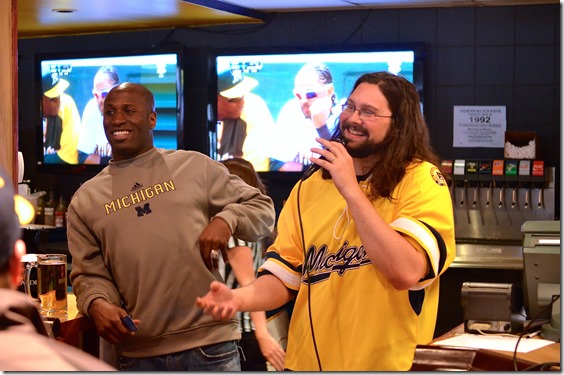
photoshoppers, start your GNUs
So we did the meet and greet Q&A thing, and other than the liveblog portion being pretty much a disaster, A+++ would do again. I couldn't type fast enough to keep up with all the good info in the Q&A so below I've written up those answers plus some we answered after the fact via email. 
We're tentatively talking another one the Friday night before the Notre Dame game, so calendar that. If you're coming in from out of town, Jared of Sports Power Weekends, who sponsored this whole thing, mentioned he's putting together a trip for that weekend that includes tickets for the game and a private tour of the Big House before we do drinks and ALL THE SHANE MORRIS.
Some things went way better than expected and other things not so much. Didn't go well: We had no way to plug our mic into the speaker system, fortunately remembering just in time that bartenders have friends with guitar amplifiers. The other thing that could have gone better is we forgot to warn Brian that Jehu Chesson was in the audience before your favorite blogger launched into his heuristic reasoning as to why Amara Darboh would be more effective this year because Chesson is still a waif.
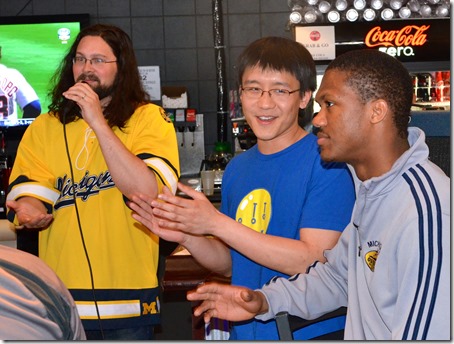
New heuristic: Chesson sitting = Heiko standing minus an inch.
Did go well: lots of luminaries showed up. Players current and former included Chesson, Countess, Donovan Warren, and John Duerr. An incomplete list of bloggers: Bryan Mac (aka BiSB), MGoPhotographers Eric Upchurch and Bryan Fuller, Burgeoning Wolverine Star, Lloyd Brady, M-Wolverine, Craig Ross, and LSAClassof2000. Epic shirts: Heiko's bubble screen smile, and a Branch-Morelli sweatshirt.
In things that surpassed all expectations, let me being with actual nicest guy in the universe Marlin Jackson himself. Walking out of the game to his car took about 25 minutes because he signed every hat, helmet, t-shirt or whatever thing put before him. We talked NBA decisions, how the Jake Butt TD was on Jarrod Wilson's as-yet-unadvanced field awareness, and that the biggest difference with this staff is they "teach football."
After being introduced by Brian as "the man who still has Reggie Williams in his back pocket," to kick off the Q&A Marlin talked about his Fight for Life Foundation. He was candid about his youth: Jackson grew up in the projects with a mother addicted to drugs and a father he never met. As you can imagine this isn't the best way to learn things like accountability, the value of an education, or even your own value and that of others. Marlin learned these things through Michigan; it's the goal of his foundation to give similarly underprivileged kids the opportunities he received because of his athletic talents.
Fight for Life runs three programs: Field of Dreams (link) is an in-school and after school program that basically helps get the kids back up to speed with their classmates. Seal the Deal (hyperlink) is a series of leagues and football camps for youth through high school with an educational/character-building component. R.A.P. (reach out and access your peers – url) is an SEL* program that gets kids to open up through, e.g. a discussion of their future aspirations or by presenting a paper on their favorite song lyrics. They need to raise about $200k per year to fund these programs.
* Social and Emotional Learning, the spread offense of education. Full context is linked above but you may cognate as learning that's the opposite of 'Another Brick in the Wall.'
We then talked about things like that one year the Colts paired Manning with a real defense, which receivers were the hardest to cover, and his impressions on the young defensive players at Michigan today. That after the jump. But first here's three generations of next-Woodsons:
Fuller has a nicer version on the Flickr collection but this one I took on Countess's phone is superior for capturing our new official Robot Ace Anbender headshot.
[jump]
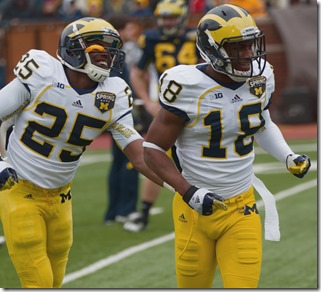
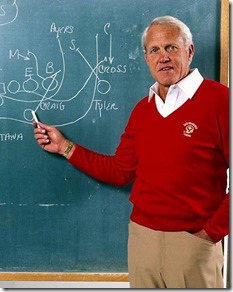
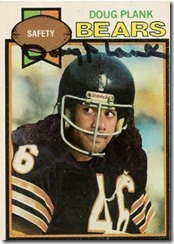
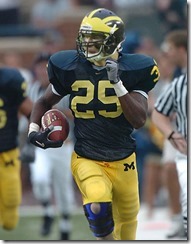
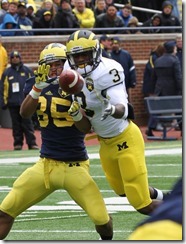
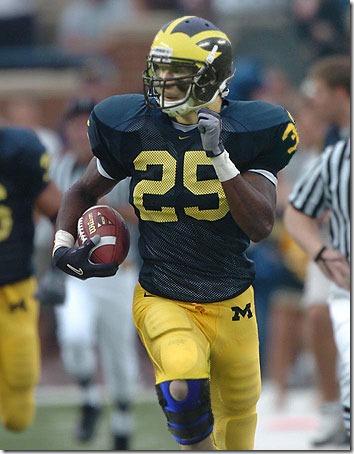



72